Achievement of Curriculum for Excellence levels: 2021/22
Achievement of Curriculum for Excellence (CfE) Levels 2021/22 provides information on national performance in literacy and numeracy, based on all pupils in publicly funded Primary 1, Primary 4, Primary 7 and Secondary 3 classes, and for all pupils based in special schools/units.
This document is part of a collection
Chapter 4: Achievement of CfE Levels by pupil characteristics
Key Findings
- Female pupils outperform male pupils across all literacy organisers at all stages.
- Across all stages and organisers, the proportion of pupils achieving the expected level was lower for pupils with an Additional Support Need than for those without.
- For most stages and organisers the proportion of pupils achieving the expected level was lower for pupils with English as an Additional Language than for those for whom English is the main language.
- A higher percentage of pupils of Asian-Chinese ethnic background achieved the expected CfE levels in numeracy compared to pupils of other ethnic backgrounds, at all primary stages and S3 (Fourth Level).
- At P1 stage, the percentage of pupils achieving the expected level was highest for pupils living in accessible rural areas compared to those living in other areas. At P4 and P7, performance was highest for pupils from either large urban areas or accessible rural areas.
4.1 Achievement of CfE Levels by Sex
Compared to 2020/21 (see Table 3 in the supplementary tables), the proportion of pupils achieving the expected CfE levels in 2021/22 has increased across all primary stages and organisers, for both male and female pupils. The size of these increases was broadly similar for male and female pupils, with female pupils gaining slightly more at P1 and male pupils at P7.
In 2021/22, female pupils outperformed male pupils across all literacy organisers at all primary stages and S3 levels. The biggest difference was in writing. Female pupils also outperformed male pupils in numeracy in P1 and S3. This pattern of differences in levels of performance between male and female pupils has been largely consistent since 2016/17.
The largest difference in performance in the literacy organisers among primary pupils in 2021/22 was in writing in P7 with female pupils outperforming male pupils by 13 percentage points. The smallest difference at primary for the literacy organisers was in reading for P4, where female pupils outperformed male pupils by about six percentage points. For S3 (Third Level or better), the largest difference in performance between male and female pupils was in writing at seven percentage points, whereas the smallest difference for the literacy organisers was in listening and talking at five percentage points.
For literacy, female pupils outperformed male pupils by 10 percentage points at P1 and P4, and 12 percentage points at the P7 stage. A broadly similar pattern was observed in previous years. The gap in literacy performance by sex amongst S3 pupils at Third Level was seven percentage points.
Across all stages the smallest difference in performance by sex was in numeracy. In 2021/22, female pupils outperformed male pupils by two percentage points at P1 in numeracy. They also outperformed male pupils by two percentage points at S3. However, male pupils performed slightly better than female pupils at P4. Female and male pupils had a similar performance at P7.
Chart 5 shows performance in literacy and numeracy by sex for each primary stage and S3 stage.
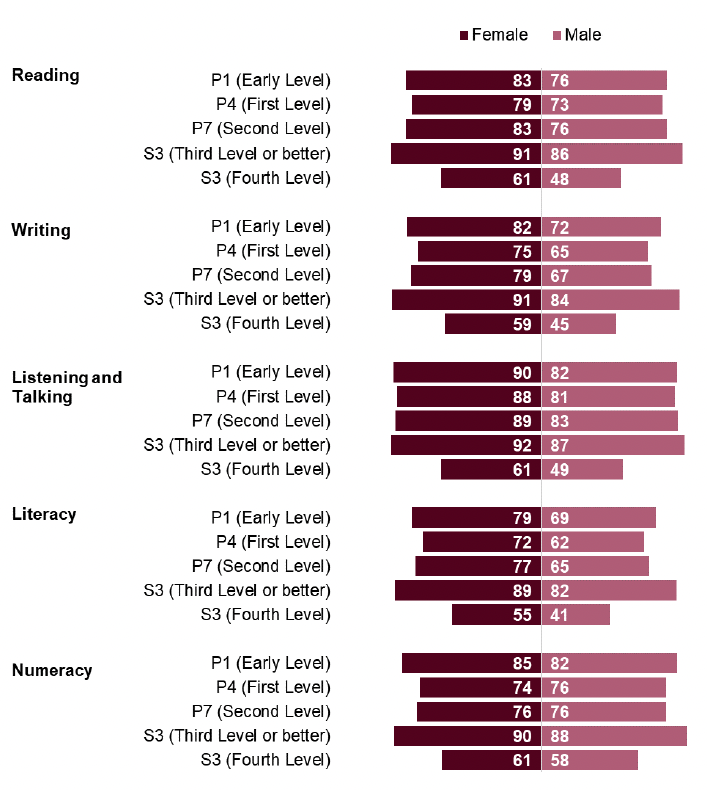
4.2 Achievement of CfE Levels by Ethnicity
For context, the majority of pupils in the Achievement of CfE Levels data collection were White – Scottish (74 per cent of all pupils), followed by White – non-Scottish (13 per cent of all pupils). The remaining ethnic groups each made up two per cent or less of all pupils. The relative sizes of these groups of pupils should be kept in mind when interpreting results.
In 2021/22, the percentage of primary school pupils achieving the expected CfE Level in literacy and numeracy increased across most ethnic groups compared to 2020/21 (see Table 4 in the supplementary tables).
Performance in numeracy was highest for pupils of an Asian – Chinese background, across all primary stages. This pattern has been consistent since 2016/17. In 2021/22, 93 per cent of Asian – Chinese pupils achieved the expected level in both P1 and P4, and 91 per cent of Asian – Chinese pupils achieved the expected level in P7.
In P1, performance in literacy was highest for pupils from Asian – Chinese and mixed or multiple ethnic backgrounds (84 and 82 per cent respectively); pupils from Asian – Chinese and Asian – Indian backgrounds performed best at P4 (82 and 79 per cent respectively) and also at P7 (83 per cent for pupils from Asian – Chinese backgrounds and 82 per cent for pupils from Asian – Indian backgrounds).
Chart 6 shows performance in literacy and numeracy by ethnicity for each primary stage.
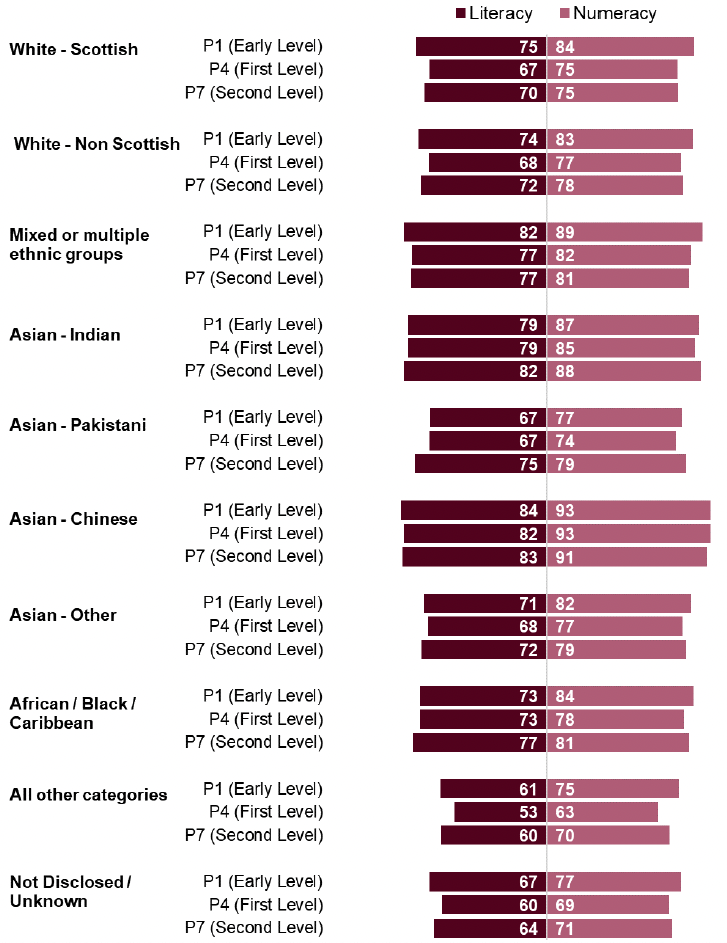
At S3 (Third Level or better), performance in both literacy and numeracy was highest for pupils from Asian – Chinese and Asian – Indian backgrounds (Table 2 below).
| Ethnicity |
Reading |
Writing |
Listening & Talking |
Literacy |
Numeracy |
|---|---|---|---|---|---|
| White - Scottish |
88 |
87 |
89 |
85 |
88 |
| White - Non Scottish |
89 |
88 |
90 |
86 |
91 |
| Mixed or multiple ethnic groups |
91 |
90 |
92 |
89 |
95 |
| Asian - Indian |
94 |
95 |
96 |
93 |
97 |
| Asian - Pakistani |
94 |
93 |
93 |
91 |
94 |
| Asian - Chinese |
94 |
95 |
94 |
93 |
96 |
| Asian - Other |
89 |
88 |
89 |
87 |
93 |
| African / Black / Caribbean |
92 |
91 |
92 |
90 |
92 |
| All other categories |
77 |
78 |
80 |
75 |
87 |
| Not Disclosed / Unknown |
79 |
78 |
80 |
76 |
86 |
| All pupils |
88 |
87 |
89 |
86 |
89 |
4.3 Achievement of CfE Levels by Additional Support Need (ASN) status
The following chapter provides information on the proportion of pupils with Additional Support Needs who achieved the expected CfE Levels. For context, the percentage of pupils recorded as having an Additional Support Need increased throughout the stages: 10, 25, 32 and 35 per cent for P1, P4, P7 and S3 pupils respectively.
Chart 7 shows that the percentage of pupils achieving the expected CfE level was higher for pupils recorded as not having an Additional Support Need (ASN) compared to pupils with a recorded ASN, across all stages and organisers.
Considering the four main organisers – reading, writing, listening and talking and numeracy - the difference in performance in P1 was lowest for numeracy (21 percentage points). At both P4 and P7 stages, the difference was lowest for listening and talking (24 and 22 percentage points respectively).
At S3 (Third Level or better), the lowest percentage point difference was in listening and talking (15 percentage points), with 95 per cent of pupils with no ASN achieving this level, compared to 80 per cent of pupils with a recorded ASN.
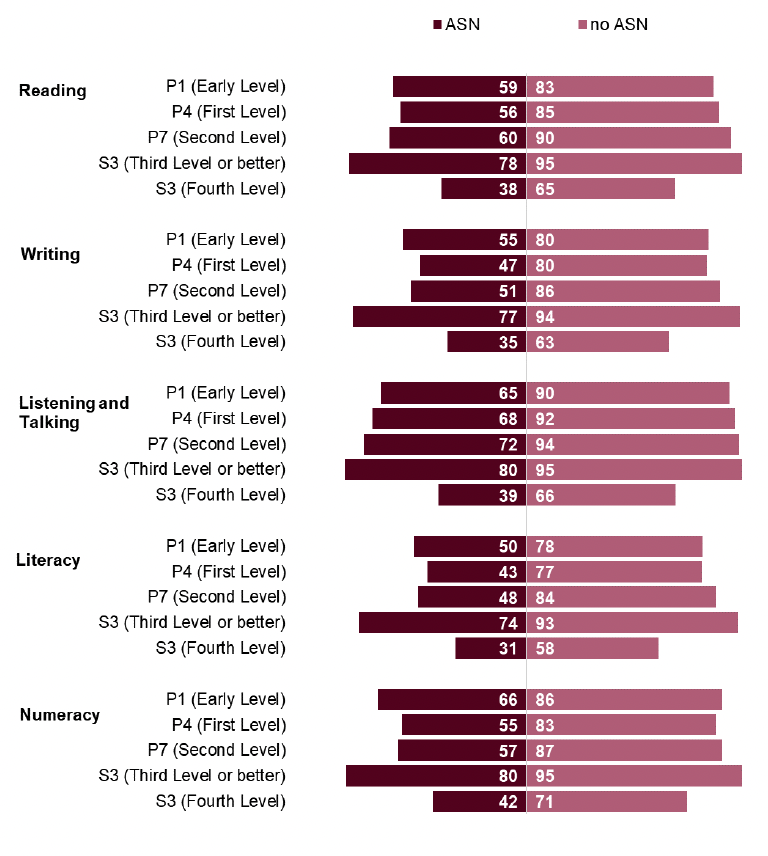
The greatest difference in performance between primary pupils with a recorded ASN and primary pupils with no recorded ASN was in writing for all three stages (26 percentage points for P1, 33 percentage points for P4 and 35 percentage points for P7).
At S3 (Third Level or better), the greatest difference in performance was also in writing (18 percentage points).
Time series data (available in Table 6 in the supplementary tables) shows that the percentage of primary pupils achieving expected CfE levels in 2021/22 was greater than in 2020/21 across all stages and organisers both for pupils with a recorded ASN and for those without. For P1 pupils, the sizes of these increases were broadly similar for those with a recorded ASN and for those without. For P4 and P7, the increases were typically slightly larger for pupils with an Additional Support Need than for those without.
Compared to 2018/19, the pattern is less clear although for P7 pupils with an ASN the proportion achieving the expected level in 2021/22 was greater than in 2018/19 for all organisers.
4.4 Achievement of CfE Levels by English as an Additional Language (EAL) status
For context, around seven per cent of pupils in the 2021/22 data collection were recorded as having English as an Additional Language (EAL).
The percentage of pupils achieving the expected CfE level was higher for pupils with English as their main language across most stages and organisers (Chart 8).
In 2021/22, the gap in performance between EAL pupils and pupils with English as their main language was lowest in numeracy; S3 pupils with EAL slightly outperformed their counterparts. The gaps in numeracy performance at other stages ranged from two and one percentage points for P4 and P7 pupils respectively, to seven percentage points for P1 pupils.
EAL pupils performed better in listening and talking than they did in the other literacy organisers at all three primary stages (76, 78 and 80 per cent for P1, P4 and P7 respectively); with the same pattern being observed in the overall results for all pupils. However, the largest gap in performance between EAL and English as main language primary pupils was also in listening and talking (11 percentage points at P1).
Overall, amongst primary school pupils, the performance gaps in the literacy organisers were generally smallest at P4 and P7 (ranging from four to seven percentage points) and largest at P1 (8 to 11 percentage points).
Compared to 2020/21, the proportions of primary school pupils achieving the expected levels in literacy and numeracy increased for both pupils with English as their main language and pupils with English as an Additional Language; with broadly similar levels of increases observed in each group. However, when compared to 2018/19, the proportion of EAL pupils (P1, P4 and P7 combined) achieving the expected levels increased for reading and listening and talking and remained unchanged for writing and numeracy, but decreased for pupils with English as main language, across all organisers (See Table 7 in the supplementary tables).
Similar patterns of change could be observed at the S3 stage (Third level or better), with the proportion of EAL pupils either remaining at the 2018/19 level or increasing slightly whilst there were typically small decreases amongst pupils with English as their main language.
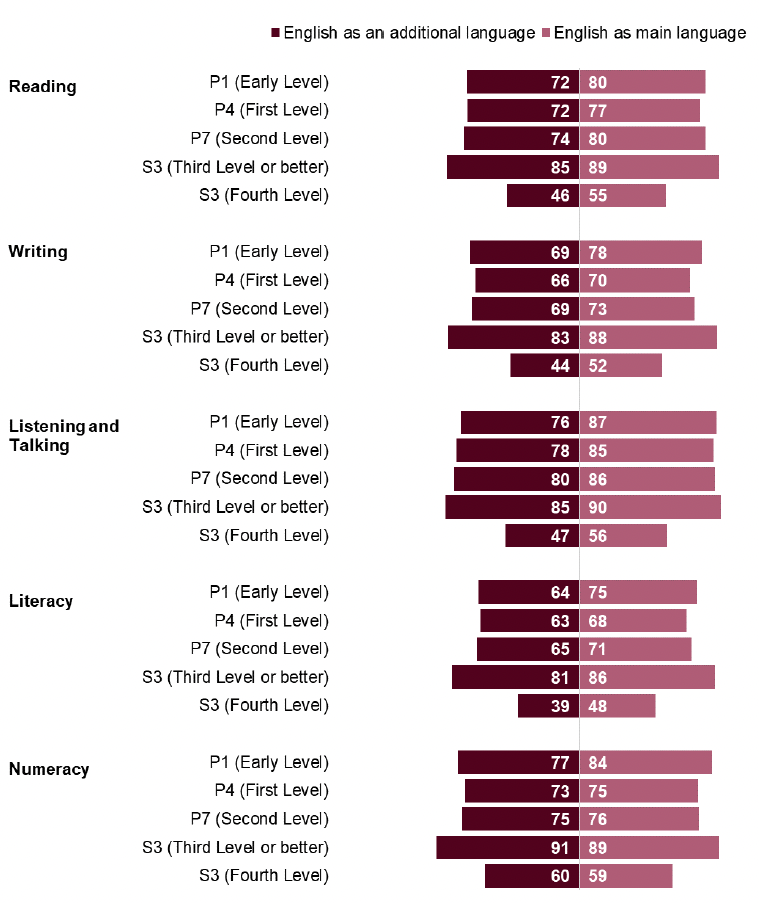
4.5 Achievement of CfE Levels by Urban Rural Classification
The Urban Rural Classification used in this publication has six classifications as shown in Table 3. The P1, P4, P7 and S3 pupils in the Achievement of CfE Levels 2021/22 data collection were distributed as follows:
| Urban Rural Classification |
Percentage of pupils |
|---|---|
| Other urban areas |
37 |
| Large urban areas |
31 |
| Accessible rural areas |
14 |
| Accessible small towns |
9 |
| Remote rural areas |
5 |
| Remote small towns |
3 |
| Unknown |
1 |
Chart 9 shows a summary of the percentage of pupils achieving expected CfE levels in literacy and numeracy, by Urban Rural Classification and stage. Detailed results by Urban Rural Classification can be found in the supplementary tables.
At the P1 stage, performance was highest for pupils from accessible rural areas across all organisers. Performance was lowest for pupils from remote small towns for most organisers.
Performance at P4 and P7 was lowest for pupils from remote small towns and remote rural areas across all organisers.
In 2021/22, the percentage of primary school pupils achieving the expected CfE levels in literacy and numeracy increased across all urban and rural areas, compared to 2020/21 (See Table 5 in the supplementary tables).
The percentage of S3 pupils achieving Third Level or better across all Urban Rural classifications and across all organisers ranged between 81 and 91 per cent. For the literacy organisers the percentage of S3 pupils achieving Third Level or better was typically slightly higher in accessible small towns and accessible rural areas than in other categories.
The percentage of S3 pupils achieving Fourth Level across all Urban Rural classifications and across all four organisers ranged between 45 and 64 per cent. For the literacy organisers the percentage of S3 pupils achieving this level was typically slightly higher in large urban areas and accessible rural areas than in other categories.
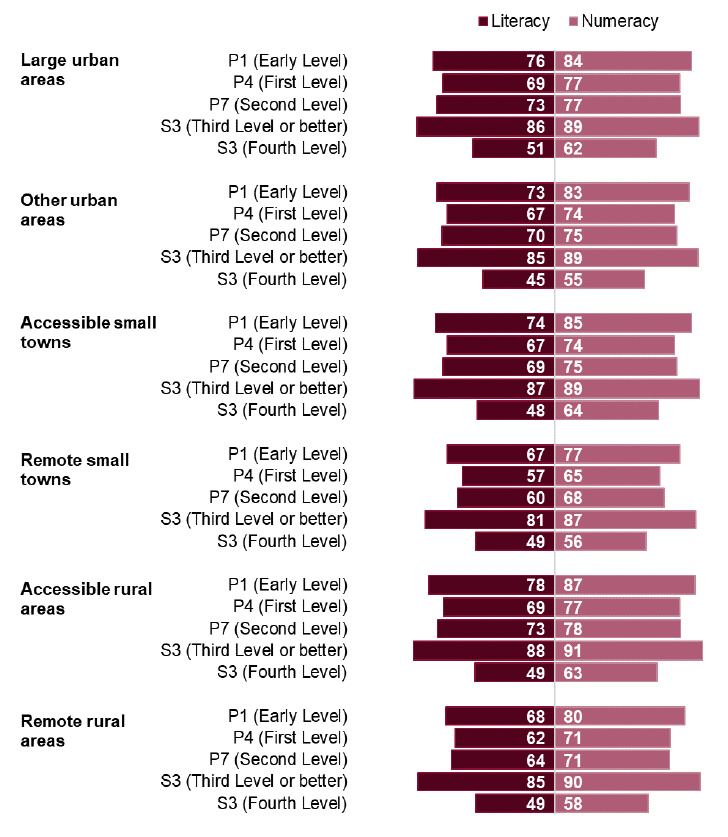
Contact
Email: school.stats@gov.scot
There is a problem
Thanks for your feedback